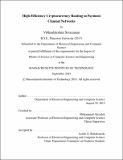| dc.contributor.advisor | Mohammad Alizadeh. | en_US |
| dc.contributor.author | Sivaraman, Vibhaalakshmi. | en_US |
| dc.contributor.other | Massachusetts Institute of Technology. Department of Electrical Engineering and Computer Science. | en_US |
| dc.date.accessioned | 2020-03-09T18:59:15Z | |
| dc.date.available | 2020-03-09T18:59:15Z | |
| dc.date.copyright | 2019 | en_US |
| dc.date.issued | 2019 | en_US |
| dc.identifier.uri | https://hdl.handle.net/1721.1/124129 | |
| dc.description | This electronic version was submitted by the student author. The certified thesis is available in the Institute Archives and Special Collections. | en_US |
| dc.description | Thesis: S.M., Massachusetts Institute of Technology, Department of Electrical Engineering and Computer Science, 2019 | en_US |
| dc.description | Cataloged from student-submitted PDF version of thesis. | en_US |
| dc.description | Includes bibliographical references (pages 67-73). | en_US |
| dc.description.abstract | With the growing usage of Bitcoin and other cryptocurrencies, many scalability challenges have emerged. A promising scaling solution, exemplified by the Lightning Network, uses a network of bidirectional payment channels that allows fast transactions between two parties. However, routing payments on these networks efficiently is non-trivial, since payments require finding paths with sufficient funds, and channels can become unidirectional over time blocking further transactions through them. Today's payment channel networks (PCNs) exacerbate these problems by attempting to deliver all payments atomically. This thesis presents the Spider protocol, a protocol inspired by congestion control for data networks that addresses these challenges. We formalize the PCN routing problem as an optimization problem and motivate Spider using that. Spider splits payments into transaction units and uses an explicit multipath transport protocol to control the rates at which the transaction units are sent through the PCN. Spider routers signal congestion to end-hosts based on observed queuing delay and end-hosts accordingly adjust sending rates on their paths. This thesis shows through extensive simulations that Spider requires less than 25% of the funds needed by state-of-the-art approaches to successfully route over 95% of the transactions across a wide range of synthetic and real topologies. Our improvements are significant across all sizes of transactions: Spider completes 40% more of the largest 25% of transactions attempted on the real Lightning Network topology compared to the state-of- the-art. | en_US |
| dc.description.statementofresponsibility | by Vibhaalakshmi Sivaraman. | en_US |
| dc.format.extent | 81 pages | en_US |
| dc.language.iso | eng | en_US |
| dc.publisher | Massachusetts Institute of Technology | en_US |
| dc.rights | MIT theses are protected by copyright. They may be viewed, downloaded, or printed from this source but further reproduction or distribution in any format is prohibited without written permission. | en_US |
| dc.rights.uri | http://dspace.mit.edu/handle/1721.1/7582 | en_US |
| dc.subject | Electrical Engineering and Computer Science. | en_US |
| dc.title | High-efficiency cryptocurrency routing in payment channel networks | en_US |
| dc.type | Thesis | en_US |
| dc.description.degree | S.M. | en_US |
| dc.contributor.department | Massachusetts Institute of Technology. Department of Electrical Engineering and Computer Science | en_US |
| dc.identifier.oclc | 1142812072 | en_US |
| dc.description.collection | S.M. Massachusetts Institute of Technology, Department of Electrical Engineering and Computer Science | en_US |
| dspace.imported | 2020-03-09T18:59:14Z | en_US |
| mit.thesis.degree | Master | en_US |
| mit.thesis.department | EECS | en_US |
